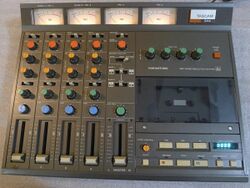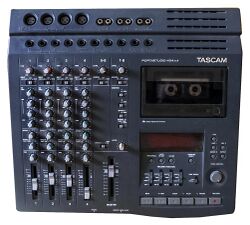Engineering:Portastudio
The TASCAM Portastudio was the first four-track recorder based on a standard compact audio cassette tape. The term portastudio is exclusive to TASCAM, though it is generally used to describe all self-contained cassette-based multitrack recorders dedicated to music production. The Portastudio, and particularly its first iteration, the Teac 144, is credited with launching the home-recording wave, which allowed musicians to cheaply record and produce music at home,[1] and is cited as one of the most significant innovations in music production technology.[2]
The Teac 144 Portastudio made its debut in 1979, at the annual meeting of the Audio Engineering Society. It was followed by several other models by TASCAM,[3] and eventually by several other manufacturers.[4]
For the first time it enabled musicians to affordably record several instrumental and vocal parts on different tracks of the built-in four-track cassette recorder individually and later blend all the parts together, while transferring them to another standard, two-channel stereo tape deck (remix and mixdown) to form a stereo recording.[5]
The Tascam Portastudio 244, introduced in 1982, improved upon the previous design with overall better sound quality and more features, including: dbx noise reduction, dual/concentric sweepable EQ's, and the ability to record on up to 4 tracks simultaneously.[6]
In general, these machines were typically used by amateur and professional musicians to record demos, although they are still used today in lo-fi recording. The analog portastudios by TASCAM (a division of TEAC) and similar units by Fostex, Akai, Yamaha, Sansui, Marantz, Vestax, Vesta Fire, TOA, Audio-Technica, Peavey, and others generally recorded on high-bias cassette tapes. Most of the machines were four-track, but there were also six-track and eight-track units. Some newer digital models record to a hard disk, allowing for digital effects and up to 32 tracks of audio.
Function
This section does not cite any external source. HandWiki requires at least one external source. See citing external sources. (March 2023) (Learn how and when to remove this template message) |
The Portastudio supported the bouncing of content between tracks, such as creating a mix of three tracks and recording the sum onto the fourth track. By carefully balancing the volume and equalization, this could be done multiple times to create very lush tracks, reminiscent of the complex four-track production of late-sixties Beatles compositions. A limitation was the introduction of tape hiss, which was a particular issue with early models. This was eliminated with more recent digital models.
Unlike standard audio cassette machines that recorded a pair of stereo channels per side, the cassette-based Portastudios recorded four channels in one direction. If you played back a standard two-sided stereo cassette, the second two channels would play in reverse.
An additional feature was support for external signal processing during recording and on final output.
Notable usages
- Seal originally recorded his multiple Grammy award-winning single Kiss from a Rose on a Tascam 244.[7]
- William and Jim Reid of The Jesus and Mary Chain used a TASCAM Portastudio to record their first demos sent to Bobby Gillespie and Alan McGee.[8]
- Madlib recorded his first album as Quasimoto, "The Unseen", on a TASCAM Portastudio.[9]
- Portastatic was named after the Portastudio Mac McCaughan used to record the songs that became its first album.[10]
- Clive Gregson and Christine Collister recorded their 1987 album Home And Away on a TASCAM (referred to as 'TEAC' in the album sleeve notes) 244 Portastudio.[11]
- Mac Demarco recorded his 2012 debut mini-LP Rock and Roll Night Club with a TASCAM 244 Portastudio. It made extensive use of the 244's pitch control and used the method of bouncing 3 separate tracks down to a single track.[12]
See also
- Multitrack recording
References
- ↑ Molenda, Michael (2007). The Guitar Player Book: 40 Years of Interviews, Gear, and Lessons from the World's Most Celebrated Guitar Magazine. Hal Leonard Corporation. p. 180. ISBN 9780879307820. https://books.google.com/books?id=02X2M-BP2OsC&pg=PA180.
- ↑ Cameron, Samuel (2015). Music in the Marketplace: A Social Economics Approach. Routledge. p. 84. ISBN 9781317934738. https://books.google.com/books?id=WhCUBwAAQBAJ&pg=PA84.
- ↑ Novak, David (2013). Japanoise: Music at the Edge of Circulation. Duke UP. p. 207. ISBN 9780822397540. https://books.google.com/books?id=hEK2AgAAQBAJ&pg=PA207.
- ↑ "The Tascam Portastudio Through the Ages". 28 September 2016. https://reverb.com/news/the-tascam-portastudio-through-the-ages.
- ↑ Alberts, Randy (2003). TASCAM: 30 Years of Recording Evolution. Hal Leonard Corporation. ISBN 9780634011566. https://books.google.com/books?id=xbA-0fAi20cC&pg=PA31.
- ↑ "TASCAM Portastudio 244 Review", Home Studio Recording Magazine (Dec 1983): 16–17, December 1983, http://www.muzines.co.uk/articles/tascam-244-portastudio/2770, retrieved 22 February 2023
- ↑ "What Makes This Song Great? Ep.105 SEAL". https://www.youtube.com/watch?v=Hhgoli8klLA&9m15s.
- ↑ Howe, Zoë (2014). Barbed Wire Kisses. United Kingdom: Polygon. p. 10. ISBN 978-1-84697-331-4. http://www.zoehowe.com/.
- ↑ "Madlib | Redbull Music Academy" Redbullmusicacademy.com .
- ↑ Parker, Chris (2008-09-10). "Mac McCaughan: Through with Portastatic?" Indyweek.com.
- ↑ "Clive Gregson And Christine Collister - Home And Away". http://www.discogs.com/Clive-Gregson-And-Christine-Collister-Home-And-Away/release/5155182. Retrieved 13 January 2015.
- ↑ "Ben Berke and Jay Mamana - Varispeed and Beyond". http://tapeop.com/interviews/120/mac-demarco/. Retrieved 22 September 2017.
External links
 |



